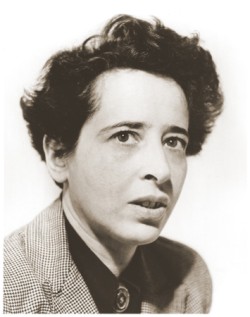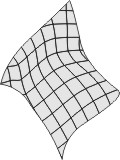


Fred Stein portrait, after 1941
Hanna Arendt, born Linden, Germany Oct. 14, 1906, died
New York, Dec. 14, 1975.
|

My drawing.
|
I finally had the opportunity to read Hannah Arendt's famous book The Origins of Totalitarianism after coming across a paperback copy of it at a library book sale. It is an important book, but its importance makes its shortcomings all the more unfortunate.
The lesser of its two major shortcomings is that it combines into a single volume material which is too disparate and by doing so it exaggerates the connection between them. The disparate elements are anti-Semitism, i.e., prejudice against Jews, and totalitarianism. The implication is that anti-Semitism is a marker for totalitarianism and that Jews are uniquely the victims of totalitarianism, which is hardly the case.
The second, and more important, weakness of the book is the weakly motivated labeling of the Soviet Union as one of the two examples of totalitarianism in the 20th century. Nazi Germany, of course, is the other one. Arendt experienced Nazi Germany herself, and, for a politically observant person, this is certainly a basis for drawing conclusions about it. But her rationale for including the Soviet Union is based on US cold-war propaganda, which can hardly be considered objective.
Arendt was a university-trained observer of social and human relationships. Her decidedly unscientific use of propaganda as fact can hardly have been accidental. My conclusion is that she had a very decided political agenda herself.
Arendt was a committed Zionist and the book was written in 1945, three years before the creation of Israel as a state from Palestinian land. In 1945 Zionism had to gain the support of the US in its project of creating a state. It recognized that it had to demonstrate to the US elites that Jews, especially a Jewish state, could be a useful ally. In the immediate post-WW2 era the principal US foreign policy objective was the destruction of the Soviet Union. Unfortunately for the Zionist project, to the US elites of the 1930's and '40's Jews and Communists were nearly synonymous concepts. The breakage of this linkage was essential: Zionism had to demonstrate that Jews were anti-communists.
It is my hypothesis that Arendt's unscientific linkage of the Soviet Union to Nazi Germany under the label of totalitarianism was an important demonstration that Zionism could mobilize Jews on behalf of a critical US foreign policy objective.
For a brief on-line biography of Arendt click on the following link:

Graph Paper tool |

Power Clipped grid |

Envelope tool |
My drawing program (Corel) has a Graph Paper tool that automatically draws a rectangular grid an example of which is shown above on the left. The number of horizontal and vertical elements as well as the line thickness and the line and background colors are arbitrary.
The drawing program also has a Power Clip feature that enables the user to insert an arbitrary drawing element into an arbitrarily shaped container as shown in the center.
It also has an Envelope tool with which you can impart an arbitrary distortion to an element as shown on the right.
By dividing the subjects jacket into sections to serve as Power Clip containers, setting the parameters of the Graph tool object to match the density of the pattern of the jacket's cloth, using the Envelope tool to shape the pattern and the containers, and finally fitting the pieces together I was able to create a reasonable replication of her jacket.
My interpretation of the subject, while it is derived from the photograph, differs from it in that it shows the subject somewhat apprehensive and distressed and looking straight at the viewer. Considered as an attempt to copy the drawing it fails in important respects.